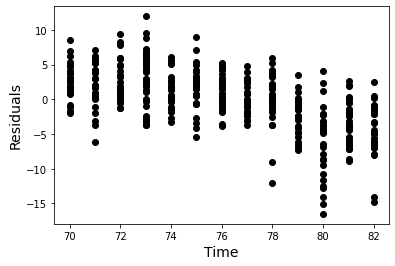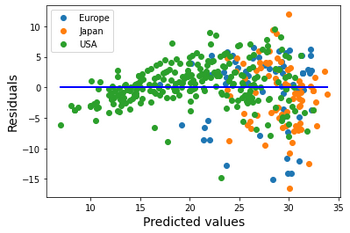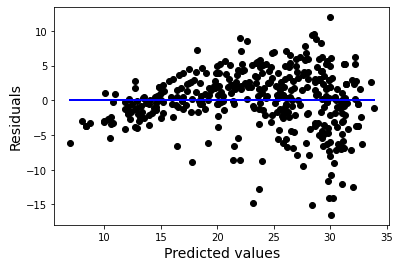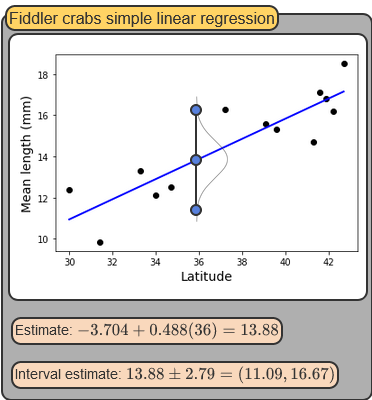
CISC482 - Lecture11
Regression 2
Dr. Jeremy Castagno
Class Business
Schedule
Today
- Assumptions of Linear Regression
- Multiple Linear Regression
Review
Review Simple Linear Regression
- What is the model for linear regresion: \(\hat{y} = ?\)
- What is residual?
- What is the loss function to solve for the parameters
- \(L(\beta_0, \beta_1) = \sum\limits_{i=1}^{n}[y_i - \hat{y}_i]^2\)
- \(L(\beta_0, \beta_1) = [y_i - (\hat{\beta}_0 + \hat{\beta}_1 x_i)]^2\)
Formulas?
\(\beta_1 (slope) = \frac{\sum\limits_{i=1}^{n}[(x_i-\bar{x})(y_i- \bar{y})]}{\sum\limits_{i=1}^{n} (x_i - \bar{x})^2}\)
\(\beta_0\) (intercept) = \(\bar{y} - \beta_1 \bar{x}\)\(\hat{\beta}_1 (slope) = \frac{\text{Cov}(x,y)}{s_x^2} = r\frac{s_y}{s_x}\)
\(\beta_0\) (intercept) = \(\bar{y} - \beta_1 \bar{x}\)
Assumptions
Assumptions of Linear Regression
- \(x\) and \(y\) have a linear relationship.
- The residuals of the observations are independent.
- The mean of the residuals is 0 and the variance of the residuals is constant.
- The residuals are approximately normally distributed.
Linear Relationship?
Residual Plot
Independence of Error
- The distances from the regression line to the points (residuals) should generally be random.
- You do not want to see patterns
- Was the previous plot of residual showing patterns, or was it more or less random?
Residual are independent?

Examples of Dependence
- Time dependence can often be assessed by analyzing the scatter plot of residuals over time.
- Spatial dependence can often be assessed by analyzing a map of where the data was collected along with further inspection of the residuals for spatial patterns.
- Dependencies between observational units must be assessed in context of the study.
Example - Time

Example - Space

Discussion
- In these graphs we saw time and spatial dependencies in our data set.
- We saw this by plotting residual plots and looking for any patterns.
- Recall the model was: \(MPG = m \cdot Weight + b\)
- Does the independence of error assumption hold in this model?
- Does that mean we should never use this model?
Mean and Variance of Error
Keeping error low and consistent
- The residuals of a fitted linear model has a mean of 0. Always.
- A mean of 0 means that on average the predicted value is equal to to the observed value.
Example, Residual 0

Example, Residual 1

Tip
Look at the y-axis scale!
Consistent Variance
- A linear regression should have a constant variance for all levels of the input.
- That means the spread of the error should be the same at all levels of input
- Level of input = x axis changing
Example, Residual 3

Example, Residual 4

Caution
Clearly see a huge jump in variance around 15
Example, MPG Prediction

Normality of Errors
- As long as the previous assumptions hold you are going to get a good simple linear regression model
- \(x\) and \(y\) have a linear relationship
- Errors are independent (no spatial, time dependence, or other feature dependence)
- Residual mean of 0, variance constant
- However, if the errors are also normally distributed, more awesomeness can be done: Interval Estimates
Interval Estimates

Full Example
- Use library
numpyandscikit-learnto fit our models scikit-learnis library made for machine learning. Its awesome!
Creating data
Creating data

Fitting the data
from sklearn.linear_model import LinearRegression
model = LinearRegression()
X = x[:, np.newaxis] # n X 1 matrix
reg = model.fit(X, y) # X needs to be a matrix
slope, intercept = reg.coef_[0], reg.intercept_
print(f"Slope: {slope:.1f}; \nIntercept: {intercept:.1f}")
ax = sns.scatterplot(x=x, y=y)
ax.axline((0, intercept), slope=slope, color='r', label='Regressed Line');
ax.set_xlabel("X")
ax.set_ylabel("Y");Fitting the data
Slope: 1.5;
Intercept: 3.9
Residual Plot
Residual Plot

Multiple Linear Regression
Definition
- Dataset has multiple input features
- Incorporate more than one input feature into a single regression equation -> multiple linear regression
- \(\hat{y} = \beta_0 + \beta_1 x_1 + ... \beta_k x_k\)
- \(x_1, ..., x_k\) = input features
- \(\hat{y}\) = predicted feature
- \(\beta_0\) = y-intercept. \(\beta_1, ..., \beta_k\) = slopes
Example
Example

3D plot
X = df[['bill_length_mm', 'flipper_length_mm']].values
y = df['body_mass_g'].values
def plot_plane(x_coef, y_coef, intercept, ax):
x = np.linspace(X[:, 0].min(), X[:, 0].max(), n)
y = np.linspace(X[:, 1].min(), X[:, 1].max(), n)
x, y = np.meshgrid(x, y)
eq = x_coef * x + y_coef * y + intercept
surface = ax.plot_surface(x, y, eq, color='red', alpha=0.5)
fig = plt.figure(figsize = (10, 7))
ax = plt.axes(projection ="3d")
ax.scatter(X[:, 0], X[:, 1], y, label='penguins')
ax.set_xlabel("Bill Length")
ax.set_ylabel("Flipper Length")
ax.set_zlabel("Body Mass")
ax.legend();3D plot

Performing Regression
model = LinearRegression()
reg = model.fit(X, y) # X needs to be a matrix
slope_bill, slope_flipper, intercept = reg.coef_[0], reg.coef_[1], reg.intercept_
print(f"Bill Slope: {slope:.1f}; Flipper Slope: {slope_flipper:.1f}; \nIntercept: {intercept:.1f}");Bill Slope: 1.5; Flipper Slope: 48.9;
Intercept: -5836.3Visualize Plane
Visualize Plane

Simple Polynomial Regression
- Special case of multiple linear regression
- Include powers of a single features as inputs in the regression equation
- Simple polynomial linear regression
- \(\hat{y} = \beta_0 + \beta_1 x + \beta_2 x^2 .. \beta_k x^k\)
- Quadratic: \(\hat{y} = \beta_0 + \beta_1 x + \beta_2 x^2\)
Example Quadratic
Fitting a Quadratic (numpy)
Plotting your regressed polynomial function
Fitting a Quadratic (SciKit Learn)
- Scikit-learn can also fit polynomials
- You must first create the additional columns manually
- In other words create a second column that is the first column squared!
- Helpful class called
PolynomialFeatures
Fitting a Quadratic (SciKit Learn)
from sklearn.preprocessing import PolynomialFeatures
pf = PolynomialFeatures(degree=2,include_bias=False)
X = x[:, np.newaxis] # n X 1 matrix
x_features = pf.fit_transform(X)
print("Transformed Features:\n", x_features[:5, :])
model = LinearRegression()
reg = model.fit(x_features, y) # X needs to be a matrix
print("Coefficients")
print(reg.coef_, reg.intercept_); # beta_2, beta_1, beta_0Transformed Features:
[[0.0 0.0]
[1.0 1.0]
[2.0 4.0]
[3.0 9.0]
[4.0 16.0]]
Coefficients
[0.3 0.1] 2.965347007117529Plotting your regressed polynomial function
Class Activity
Class Activity
Practice Multiple Linear Regression




